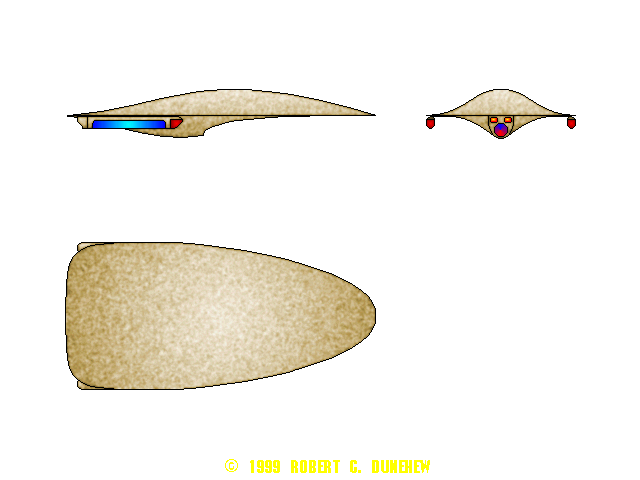

Le Mat class
General Specifications:
Length: 30.9m
Width: 14.8m
Height: 4.9m
Max. Warp: 9.997+
Cruise: 9.95+
Max. Impulse: 0.998 lightspeed
Crew: 3
Armaments: Two heavy phaser cannon of classified output coupled to the phased array; Two quantum torpedo launchers (fwd), capable of firing four torpedoes each, Four external hardpoints allow additional munitions/equipment to be carried.
Typical loadout (for one hardpoint) may be:
Type: Space Dominance (Heavy) Fighter
Status: 2 prototypes are undergoing testing at the Nova Hesperius proving grounds. Production will commence if they prove cost-effective.
About Ship:
The Le Mat is a somewhat larger, uprated redesign of the Chevalier class fighter. The intent of this excercise is to produce a fighter-sized vessel capable of delivering weaponry which can seriously threaten the largest of vessels. The Le Mat is about half the size of a Danube class runabout. It is a space dominance fighter with greatly improved capability over current Starfleet fighters.
The primary visible differences in Between the Le Mat and the Chevalier are the slight size increase, configuration of the hull, elimination of external impulse and RCS exhausts and the variable-geometry nacelles. The increased size and drive system modifications freed up more internal volume than the reconfigured hull shell eliminated, allowing for better crew accomodations and additional equipment. The gravitic slope modulator (GSM) impulse system also replaces the reaction control system, and provides greater agility than standard reaction control motors.
Four external hardpoints permit the Le Mat to be quickly reconfigured to perform tasks that required hours of reconfiguration with the Chevalier, and without loss of combat ability. Many new types of ordnance may be carried that the Chevalier wasn't designed for. The Le Mat doesn't just do what the Chevalier can -- it does more, and better.
The Le Mat's spaceframe is constructed with a variety of features which render it extremely difficult to detect. Both the shape and surface coatings of the Le Mat reduce it's sensor signature to a barely-detectable level.
The Le Mat incorporates the latest version of Holographic Hull Projectors (HHP). This makes the ship extremely difficult to detect and makes a positive weapons lock-on nearly impossible. The hull is devoid of markings that would help an enemy determine weak spots. The holographic hull surface actively displays hull markings such as registry numbers, vessel name or distinctive insignia, when desired.
The Le Mat is also equipped with the latest version of Phase-Inverting Multi-band Emission Suppression System (PIMESS). This system, in conjunction with the HHP, renders the Le Mat nearly undetectible. Depending upon conditions, this combination has proven at least as stealthy as the best cloaking devices, at a considerably reduced energy cost.
The hull incorporates a multifunction phased array. This array is an integrated network of emitters and sensors imbedded directly within the hull matrix itself, and includes sensors, phaser emitters, and tractor/deflector emitters. The array can take a significant amount of damage before performance is noticeably diminished. An added benefit of the phased array is a profound increase in sensor acuity and range, due to the large size of the array (as large as the hull). The sensor array provides the ability to precisely target objects 1 centimeter in diameter at a distance of just under 2 astronomical units.
Dual micro-toroidal matter/antimatter reactor assemblies (MT-M/ARA) provide power, supplemented by a battery of quantum flywheels. The flywheels store several hours' worth of output for combat use, allowing the vessel's power consumption to temporarily exceed generation capacity by several orders of magnitude. An additional advantage of this power storage configuration is the ability to "run silent" by shutting down the MT-M/ARAs (eliminating neutrino emissions) and operating solely from battery power. This mode of operation may be used when maximum stealthiness is required.
This robust power production system is necessary partly because it is the only power aboard the vessel, other than emergency back-up systems. Sub-light propulsion and maneuvering is provided by gravitic slope modulators (GSMs). These GSMs alter the direction and force of gravity within a localized field by manipulation of specific subspace dimensions. GSMs provide superior maneuverability with no traceable exhaust gases. Unlike the fusion impulse drives used in other vessels, this system does not generate power, an acceptable tradeoff in a military vessel.
A combination of hull configuration and dual mode nacelles permit the Le Mat to cruise at extremely high warp for extended periods of time. The additional burst of power provided by the quantum flywheels allows the vessel to increase its warp velocity to [Classified Information Deleted]. This provides a dash capability, allowing the crew to respond to or "bug out" from a bad situation faster than any known potential adversary can follow.
The Le Mat is designed to perform a variety of functions besides direct combat. A two-ship can establish a secure subspace telemetry link, effectively doubling the computer resources of each ship. This link permits the two-ship to function as a long baseline interferometer, greatly increasing the range and accuracy of the sensors aboard each vessel. This feature affords the two-ship superbly accurate targeting information. This targeting data may be transmitted to other vessels as well, giving them a "proxy" weapons lock.
The interior sections of the Le Mat are palletized, allowing rapid changout of damaged components or rapid upgrades as new technology becomes available. The Le Mat is somewhat less cramped than the Chevalier, but crews are still screened for claustrophobia, as the internal accomodations are still somewhat confining.
Return to the Starship Catalogue.